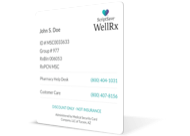Copyright 2024
Medical Security Card Company, LLC
All Rights Reserved
WellRx will never sell your personal information. Period. By signing up I agree to WellRx's terms of use and privacy policy.
By Jillian Foglesong Stabile, MD
January 26, 2024
Atrial fibrillation is a type of irregular heartbeat. It’s one of the most common types of arrhythmias treated in the United States regularly. The frequency of atrial fibrillation is increasing and by 2030 is expected to affect approximately 12 million people in the United States. So what exactly is atrial fibrillation and how is it treated?
The heart is a complicated organ, but it consists of 4 chambers. The 2 upper chambers, the atria, receive blood from the lungs or body and pump it into the 2 lower chambers, the ventricles. From the ventricles, blood is then pumped to the body or lungs. With normal rhythms, these processes happen in an organized pattern. In atrial fibrillation, the contractions of the atria are irregular and unorganized. This results in a quivering movement that is not effective at pumping blood to the ventricles. As a result, the ventricles may beat irregularly as well. The coordination of the pumping of the heart is accomplished through electrical signals that are sent through the muscle and organized in the sinoatrial (SA) node in the atria and the atrioventricular (AV) node to the ventricles.
Atrial fibrillation is usually caused by a problem with the heart structure, but it can be caused by other health problems as well. Changes in the heart muscle or valves can trigger atrial fibrillation. Low blood flow to the heart as that occurring with coronary artery disease or a heart attack can also cause atrial fibrillation. It can also be associated with inflammation, alcohol or drug use, neurological abnormalities, advanced age, and certain genetic factors.
Atrial fibrillation has several different types. These are generally named based on the duration of symptoms or whether they are constant or come and go.
This type of atrial fibrillation is when atrial fibrillation comes and goes. The heart may return to its normal rhythm on its own or may require medical intervention. Episodes of fibrillation last for less than 7 days. Episodes may occur several times a day or may become normal for weeks or months between episodes.
Persistent atrial fibrillation lasts for more than seven days. Patients with persistent atrial fibrillation don’t convert back to normal sinus rhythm. To get out of fibrillation, you will require medical intervention by a healthcare provider.
If you’ve been consistently in atrial fibrillation for more than a year, then you have longstanding atrial fibrillation.
Atrial fibrillation that lasts indefinitely is considered permanent if you and your healthcare provider have decided not to try to restore your rhythm to a normal rhythm.
As we’ve previously mentioned, atrial fibrillation may be related to diseased heart valves, but in the case of nonvalvular atrial fibrillation, the abnormal rhythm is not related to valve disease.
Atrial fibrillation may not cause any symptoms, but it generally causes an irregular heartbeat or palpitations. Other symptoms may include:
If you experience chest pain or pressure associated with atrial fibrillation, you should seek immediate medical attention by calling for emergency services at 9-1-1 as this could be a sign of a heart attack.
Certain factors can increase your risk for atrial fibrillation. Age is one of the major risk factors. Other risk factors include:
Of these risk factors, the things that increase the risk of atrial fibrillation the most are age and high blood pressure.
Many problems can be associated with atrial fibrillation, but three are most common and serious.
When blood does not flow smoothly, the platelets and other clotting factors can cause clots to form. In atrial fibrillation, the unorganized beating of the atria can lead to clot formation. These clots can then travel through the heart to other parts of the body causing a thromboembolism. The most common place for atrial fibrillation-related blood clots to travel is to the brain which can cause a lack of blood flow resulting in a stroke.
The risk of stroke in atrial fibrillation is calculated using a prediction instrument such as a CHADS2 score. Points are assigned for age, gender, other vascular disease, and other risk factors. The number of points can vary from 0-6 and the risk of stroke increases with the number of points. The risk starts at 0.5% per year and can increase as high as 7% per year based on scores. If your score is 2 or higher, your healthcare provider may recommend medication to prevent clotting.
If your heart rate is too fast or too slow and your ventricles aren’t beating in an organized fashion, it can cause your blood pressure to drop and can cause you to have altered mental status. Hemodynamic instability can also cause decreased blood flow to the heart, which can lead to a heart attack. Hemodynamic instability is an indication of to attempt to convert the abnormal rhythm back to sinus rhythm.
In some situations, atrial fibrillation can lead to other abnormal rhythms such as atrial flutter or Wolff-Parkinson-White syndrome (WPW). WPW is caused by a congenital condition but is believed to be preceded by atrial fibrillation. WPW is a reentry electrical abnormality. Patients who have this condition may respond differently to medications to treat atrial fibrillation.
If you are feeling an irregular heartbeat, your healthcare provider may recommend an electrocardiogram (EKG). Atrial fibrillation is an irregularly irregular rhythm, which can be seen in this study. If your atrial fibrillation is intermittent, a longer more continuous heart rate monitor such as a Holter monitor may be recommended. Other testing such as an echocardiogram or an ultrasound of the heart may be used to look for complications associated with atrial fibrillation.
Medications to treat atrial fibrillation usually focus on controlling the heart rate or preventing the complications associated with the abnormal rhythm.
Rate control medications come from different classes. The two most common are calcium channel blockers and beta blockers.
Calcium channel blockers work on the calcium channels in the heart muscle to decrease the heart rate in the ventricles. They aren’t used in people who have decreased contractility in those muscles because they can further decrease contractility. If you have a slow heart rate or low blood pressure, these medications may not be right for you. Calcium channel blockers may be used orally as an outpatient or may be given intravenously in the case of hemodynamic instability.
Beta-blockers slow the heart rate and decrease blood pressure. They don’t stop the abnormal rhythm, but rather they help slow it down. If you have a slow pulse or low blood pressure, these medications may not be great options for you. They are also used with caution with people with breathing problems because they can worsen these problems. Beta blockers can also be given orally or intravenously depending on the circumstances.
Digoxin may also be used to control the rate though it is less effective than beta blockers or calcium channel blockers.
In some cases, medications may be used to try to convert the rhythm from atrial fibrillation back into a normal heart rhythm. This is usually done in the hospital or other monitored setting and carries risks which your healthcare provider will advise you of if they recommend this therapy.
Blood thinners are recommended for anyone with atrial fibrillation who meets the criteria for increased risk of clotting. Generally, this is people with a CHADS2 score of 2 in men or 3 in women. Blood thinners such as warfarin are used to prevent clots. Warfarin has interactions with other medications and foods. It also requires close monitoring. Newer blood thinners include dabigatran, rivaroxaban, apixaban, and edoxaban. These don’t have as many drug interactions and don’t require as much monitoring. Which blood thinner is right for you is best left for discussion between you and your healthcare provider.
Lifestyle changes may help with atrial fibrillation. Controlling some of the risk factors associated with the condition can sometimes help:
If medication is not working or if additional measures are needed, your healthcare provider may recommend procedures such as ablation of the abnormal electrical pathways or a pacemaker. Sometimes using electrical cardioversion can put the heart back into a normal rhythm.
If your healthcare provider has diagnosed you with atrial fibrillation or any other health condition, you may be wondering how to save money on your medications. Consider using our WellRx prescription discount card. Some people save a little. Some people save a lot and prices vary across zip codes. Even pharmacies across the street from each other can have huge price differences!
References:
https://www.cdc.gov/heartdisease/atrial_fibrillation.htm
https://www.mayoclinic.org/diseases-conditions/atrial-fibrillation/symptoms-causes/syc-20350624
https://www.nhlbi.nih.gov/health/atrial-fibrillation/causes
https://www.ncbi.nlm.nih.gov/books/NBK526072/
https://pubmed.ncbi.nlm.nih.gov/8114238/
https://pubmed.ncbi.nlm.nih.gov/9358515/
https://jamanetwork.com/journals/jama/fullarticle/2397836
https://www.ncbi.nlm.nih.gov/pmc/articles/PMC6515763/
https://www.ahajournals.org/doi/10.1161/01.CIR.47.2.399
https://www.heart.org/en/health-topics/arrhythmia/about-arrhythmia/other-heart-rhythm-disorders
https://www.ncbi.nlm.nih.gov/books/NBK554437/
https://www.ncbi.nlm.nih.gov/books/NBK554437/
https://www.aafp.org/pubs/afp/issues/2016/0915/p442.html
https://www.nhlbi.nih.gov/health/atrial-fibrillation/treatment
https://www.ncbi.nlm.nih.gov/pmc/articles/PMC1569901/

For your convenience, use the ScriptSave® WellRx mobile app. Now savings are well in hand, right at the pharmacy counter. Save on your family's prescription medicines.
Learn More
Your choice. Get a ScriptSave WellRx Savings Card. Or Download the free mobile app from the App Store or Google Play Store
Get A Card
ScriptSave WellRx Grocery Guidance leverages leading-edge nutritional data science to help you know which food products on your grocery store shelf are truly good for YOU.
Healthy Foods For YouTags:

November 07, 2024

October 23, 2024

May 07, 2024
You need to log into the site to use this feature
This feature requires registration. Sign up or log in to your free WellRx account to gain access to this and other tools to help make managing your medications and wellness easier.
Benefits Include:
 Store & manage your medication list
Store & manage your medication list
 Medication pricing updates
Medication pricing updates
 Medication information
Medication information
 Pill & refill reminders
Pill & refill reminders
 Medication journal & mood log
Medication journal & mood log
This feature requires registration. Sign up or log in to your free WellRx account to gain access to this and other tools to help make managing your medications and wellness easier.
Benefits Include:
 Store & manage your medication list
Store & manage your medication list
 Medication pricing updates
Medication pricing updates
 Medication information
Medication information
 Pill & refill reminders
Pill & refill reminders
 Medication journal & mood log
Medication journal & mood log
You will be redirected to your program in 5 seconds.
Our Terms and Conditions and Privacy Policy have recently been updated.
By declining you will be logged out of your account